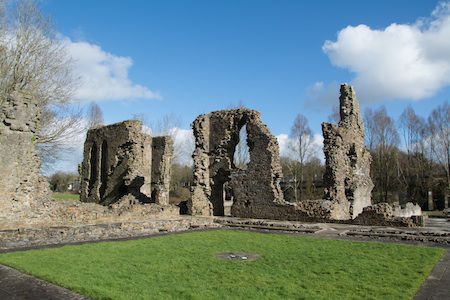The Augustinian Priory of St Mary and St Thomas

Despite being only five hundred yards from the town centre the beautiful Priory ruins remain tucked away, generally unnoticed. Although the Cistercian Order rather than the Augustinian Order was the most represented in Wales, the differences between the practices of the numerous monastic houses was often very blurred.
Founded in about 1200, the land on which the Priory stands was donated by Robert FitzTancred, grandson of Tancred, considered by many to have been the original Flemish builder of Haverfordwest Castle. In the time honoured tradition of wealthy men of power needing to secure their entry into the afterlife, the granting of land for the building of a priory might have seemed the most favourable thing to do, but Robert was not as generous as might be thought; the land that his gift formed, was at its closest point to the river, an unusable marsh and slightly away from the river it rose extremely steeply. Nevertheless, monks were unlikely to reject any offering and the Augustinian Priory of St Mary and St Thomas was begun.
The awkward task of creating a flat site on which to build was achieved by cutting away at the steep bank and depositing the excavated material into and on top of the marsh area. The consequential effect of this poor foundation was to create a structure that was always going to be slowly subsiding. In addition, the steep bank that remained, giving way to the consistently higher ground behind it, ensured that rainwater continually drained, and still does, into and around the Priory.
There were positives, however, and the position so close to the river...then the equivalent of a motorway...allowed extremely easy access. Combining this with the proximity of one of the most successful and prosperous towns in Wales guaranteed that the Priory was going to be a success....until the dissolution of the monasteries by Henry VIII, the effects of which arrived in Pembrokeshire in 1539 heralding the end of, and destruction of this Priory.
The Prior leading up to the dissolution, and who subsequently became Bishop of St Davids was William Barlow, a leading figure in assisting Henry to successfully divorce Catherine of Aragon and marry Anne Boleyn. As a reward for his efforts Barlow was given the position of Prior by Anne who had, to bolster her standing prior to her marriage to Henry, been made Marquis of Pembroke, with which title came the Lordship of Haverfordwest and the power to gift the position of Prior.
Much of the site was robbed of its stone after the dissolution and the main ruin is what remains of the Priory church.
The site was excavated by archaeologists over eleven years in the 1980/90s and renovated to a position whereby we can now enter and enjoy it.
The original herb garden is the only surviving monastic garden in this country and has been renovated and planted with examples of plants used at the time.
Leave the Priory, cross the road and begin a long gradual ascent up the path that leads to, on your left and behind the high stone wall...
Base map from openstreetmap.org
How many crosses are set in the floor of the Priory? Tap to reveal answer.